Taste the Blood of Dracula (1970)
Directed by: Peter Sasdy
Written by: Anthony Hinds
Starring: Anthony Corlan, Christopher Lee, Geoffrey Keen, Linda Hayden
UK
AVAILABLE ON BLU-RAY AND DVD
RUNNING TIME: 91 mins
REVIEWED BY: Dr Lenera, Official HCF Critic
A businessman named Weller traveling through Eastern Europe sees Dracula’s death from impalement on a large crucifix and removes a ring, a cape and a brooch with dried blood on it. In Victorian England, three English gentlemen – William Hargood, Samuel Paxton and Jonathon Secker – have formed a circle ostensibly devoted to charitable work but in reality devoted to thrill seeking. Bored after their umpteenth visit to a brothel, they meet a Lord Courtley who promises them experiences they will never forget. He gets them to buy Dracula’s ring, cloak and dried blood from Weller, then in an abandoned church asks them to drink the dried blood mixed with his own. The revolted threesome beat him to death and flee. Courtley’s body then transforms into Dracula, who vows that those who have destroyed his servant will themselves be destroyed….
Not as lively as Dracula, not as atmospheric as Dracula: Prince Of Darkness, and not as fun as Dracula Has Risen From The Grave, Taste The Blood Of Dracula is regarded by some as the finest of Hammer’s Dracula sequels, though I wouldn’t personally agree with that at all. It has some terrific moments and a very strong first third, while there’s more possibly more subtext than normal, with Dracula, finally in England as in Bram Stoker, causing the disintegration of the Victorian family, an outfit which is rife with hypocrisy. You could even say that Dracula is the real hero of the piece, rather than young Paul [Hammer really didn’t make much effort into naming their characters did they, there’s even another Lucy in this one!]. However, it rarely actually makes any sense – okay these films exist in a dark fairy tale landscape, but it’s patently obvious to anyone watching even if he or she isn’t aware of the background to the film to Dracula has been shoehorned in, and that the parts of the script have been rewritten rather too hastily. It’s rather draggy too, with little acceleration towards the end when excitement ought to be mounting. I like it, but not quite as much as many Hammer writers and fans seem to.
Kevin Francis, son of Freddie who’d just directed Dracula Has Risen From The Grave, wrote a script called Dracula’s Feast Of Blood which was rejected. Lee was refusing to play the role unless he was paid a percentage of the US distributor’s gross. Hammer said no, so turned to TV’s Ralph Bates and had Anthony Hinds write a screenplay in which Bates’s depraved aristocrat Lord Courtley returned from the grave as a Dracula-like character. When Warner Bros-Seven Arts reminded Hammer that they’d only agreed to finance the film if Lee was in it, Lee reluctantly changed his mind and Dracula was written into the script. Vincent Price was going to play a fourth member Of William Hargood’s ‘thrill seekers’ but budget cuts removed the character so his part was shared among the others. Francis later noticed that some of his scenes were in the script and complained to Hammer, who paid him some money. Shooting took at Elstree and several London locations: Scatchwood and Aldenham Park, Highgate Cemetery, St. Andrews Church, and a house in Barnet. In the UK a few brief shots had to be cut, but the American censors the MPAA [both this and the previous one were ‘PG’s in the US] ordered the removal of just over three minutes of footage: Dracula’s blood becoming powder during the opening scene, the snake charmer’s dance, shots of prostitutes in rooms with customers, the beating to death of Courtley, and close-ups of victims with blood around their mouths. The film was another hit, but the numerous hassles caused Hinds to resign as company director, and some say that Hammer never recovered.
The pre-credits scene is one of Hammer’s best openings. Weller is thrown from his carriage during a struggle over a snow globe a fellow passenger demands and knocked unconscious. After regaining consciousness, it’s night time. After wandering some way, he hears some deathly cries, and they really are deathly. Terrified, Weller runs and falls into a grassy slope. Looking up, he sees Dracula [Dracula Has Risen From The Grave footage expertly cut in] screaming in agony with a large crucifix impaling him from the back, then watches in amazement and fear as he dies and disintegrates from blood to reddish dust. Cut to Victorian England and William Hargood, Samuel Paxton and Jonathon Secker embarking on another of their illicit adventures. Hargood, a great, repulsive creation [look at the slightly incestuous relish with which he prepares to beat his daughter] well played by Geoffrey Keen, is especially hypocritical as he chastises his daughter Alice for “behaving like a harlot” even though she was just chatting to her boyfriend Paul who’s Paxton’s son. Meanwhile Secker’s son Jeremy is secretly engaged to Paxton’s daughter Lucy. Frankly the film threatens to grind to a halt whenever it spends time with its drippy young lovers, but we do get a nice striptease with a snake two and a half decades before Salma Hayek thrilled the patrons of the Titty Twister in From Dusk Till Dawn, and soon we have another really vivid scene when Lord Courtley gets Hargood and co. to join him in a Satanic ceremony, though exactly what he’s trying to do is unclear. The three refuse to drink the mixture of his and Dracula’s blood as it starts to overflow in the glasses, then Courtley drinks it himself, screams and falls to the ground. As he grabs for Hargood’s legs, all three gentlemen kick and beat him, not stopping until Courtley dies, after which they flee the scene of the crime.
All quite good so far, but when Courtley somehow, via very poor special effects, becomes Dracula, in terms of narrative things almost fall apart. The idea of Dracula using the children to kill their fathers is certainly a neat one, especially as he seems to sexually liberate them too – just notice the way Alice looks all sluttish when she’s under Dracula’s control. This Dracula can be related to the time it was made in more than any of the others except from Dracula A. D. 1972, with its vague anti-establishment ethos and its youth rising up against the constraints of the traditional family which has become repressive and hypocritical. However, it also means that Dracula does very little than give orders and count down his victims. He’s also rather dim, having several opportunities to bite Alice but never doing so. What vampire waits until just before sunrise to attempt to vampirise someone? I guess you may expect it from a low level bloodsucker but certainly not the King of Vampires. Then there’s the bit where Jeremy is bitten, but nothing is made of this except for a shot of him sporting fangs. Apparently a scene that was clearer on the matter was shot but cut for some bizarre reason. And I can never work out why Dracula is doing all this in the first place? He doesn’t appear to have ever even met Courtley. On the other hand, it’s nice to have a woman under Dracula’s control who rebels against him for a change, and therefore aid the hero in killing him, the Count trapped by crosses around the church he’s been residing in, a crucifix on a stain glass window then burning its way into his back so he falls, rather undramatically, onto the altar.
It’s best to try not to think too much about the story and enjoy the intermittent action, and there are two good kills, one by a shovel which isn’t very graphic but still rather sudden and shocking, and one when a man is staked by a female vampire [a shot of Lucy’s eyes cracking open provides quite a jolt] and her aide in an ironic reversal of what we usually see. Dracula’s biting scenes are longer and more explicit than before, while the glimpses of kinky pursuits in the brothel even include some brief topless nudity. Hammer’s usual art director Bernard Robinson had just left the company and some say that their subsequent films suffered from his absence, but actually the work of Scott MacGregor in this one is rather good, less visually pleasing than Robinson’s but very convincingly Victorian, while effective use is made of the dilapidated church too in a film that uses slightly more real locales than usual. First time director Peter Sasdy and cinematographer Arthur Grant aren’t too interested in things like the usual vivid use of colours, but there are some fun camera devices like the rapid zooms which take us closer to Courtley’s dead body, and the swirling shots of the church to show Dracula’s disorientation.
Though barely in the film, Lee’s heart doesn’t seem to be quite in it, but Michael Ripper gets to play another [and more useless than his previous one] cop and gets a nice moment when he’s just been shown into somebody’s living room and heads straight for the drinks. Anthony Corlan, later to be Anthony Higgins, and Linda Hayden are rather colourless romantic leads. On the other hand Ralph Bates is rather good as Courtley, playing with just the right amount of arrogance and air of depravity. He’d have been great playing Dorian Gray. Aida Young said that James Bernard’s music score for Dracula Has Risen From The Grave was too dissonant, so Bernard responded by basing much of his score for the follow-up on a plaintive love theme. He also brings back his original Dracula theme, though it’s used a bit less than before. It’s probably the most varied of his Dracula scores, with differing motifs for some of the scenes and even some deliberate “off” sounding organ stuff for the ceremony scene. As with The Devil Rides Out, he turns a sinister, minor key theme into a triumphant, major key one at the end. Overall Taste The Blood Of Dracula has enough to interest the viewer, but seems rather under-powered and confused.

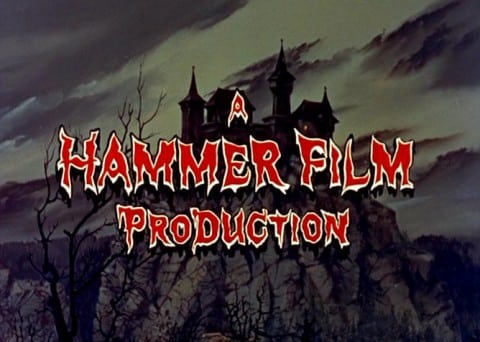
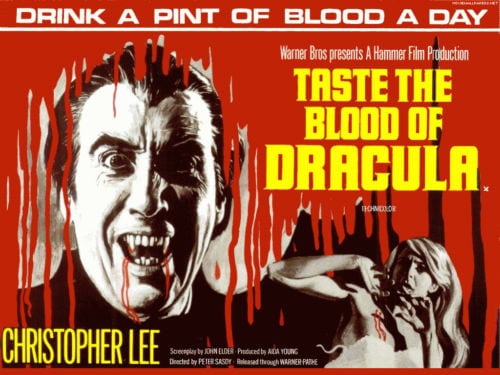
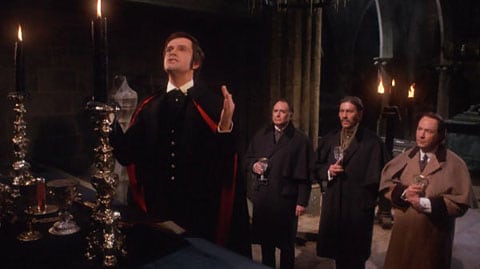
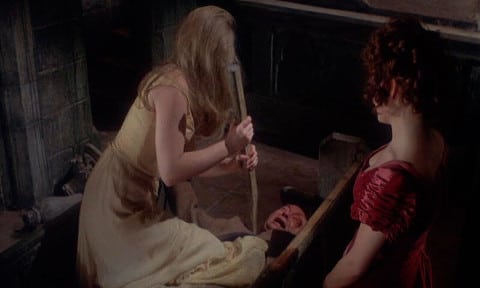




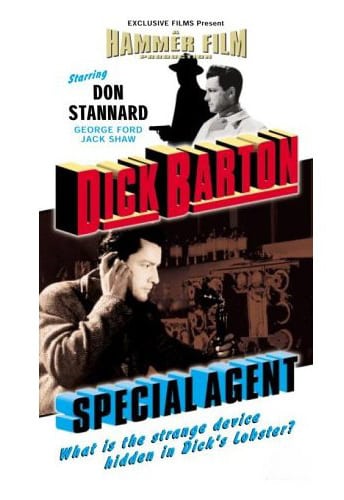
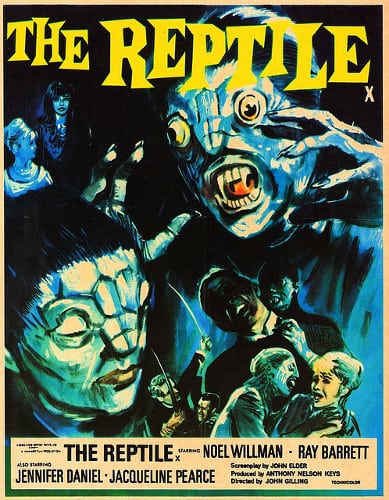
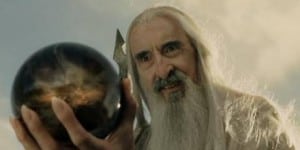
Be the first to comment